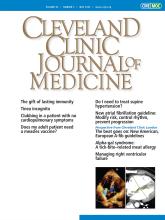Article Figures & Data
Tables
- TABLE 1
Summary of recommendations for COVID-19 in special patient populations with kidney disease
For all patients: Social distancing and hand hygiene to reduce exposure to COVID-19
Use of PPE as recommended by the CDC
Education of health care workers and patients on advances in COVID-19
In addition to above, for specific populations withChronic kidney disease (CKD): Virtual visits via telemedicine when in-person visits are not necessary
Continue RAS inhibitors in patients with stable CKD
Avoid remdesivir in patients with GFR < 30 mL/min per m2 unless benefits outweigh risks
End-stage kidney disease on home-based dialysis: Patients on peritoneal dialysis (PD): Maintain at least 2 weeks of PD supplies, remote management platforms to monitor PD sessions
Patients on home hemodialysis: Real-time monitoring of vital signs and treatment data
Home visits by healthcare workers should be avoided except for patients with disabilities or in cases of an emergency
End-stage kidney disease on in-center hemodialysis: Screening for COVID-19 symptoms and temperature checks for patients and staff depending on institution policy
Use of dedicated HD units for patients with COVID-19
Daily disinfection of dialysis equipment and supplies
Kidney transplant recipients (KTRs): Screening of donors and recipients prior to kidney transplant surgery
Ambulatory KTRs with COVID-19: continue home immunosuppression regimen
Inpatient KTRs:
Mild COVID-19 with no supplemental oxygen use: reduce MMF while maintaining CNI and steroid therapy
Severe COVID-19 requiring supplemental oxygen, dexamethasone, or remdesivir: Discontinue MMF, target lower CNI trough levels
CDC = Centers for Disease Control and Prevention; CNI = calcineurin inhibitor; GFR = glomerular filtration rate; MMF = mycophenolate mofetil; PPE = personal protective equipment; RAS = renin-angiotensin system






